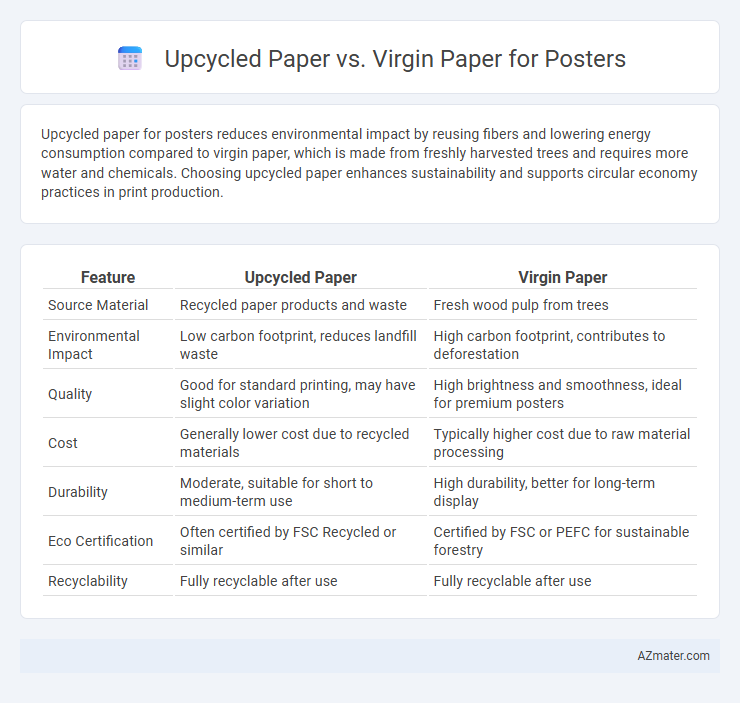Upcycled paper for posters reduces environmental impact by reusing fibers and lowering energy consumption compared to virgin paper, which is made from freshly harvested trees and requires more water and chemicals. Choosing upcycled paper enhances sustainability and supports circular economy practices in print production.
Table of Comparison
| Feature | Upcycled Paper | Virgin Paper |
|---|---|---|
| Source Material | Recycled paper products and waste | Fresh wood pulp from trees |
| Environmental Impact | Low carbon footprint, reduces landfill waste | High carbon footprint, contributes to deforestation |
| Quality | Good for standard printing, may have slight color variation | High brightness and smoothness, ideal for premium posters |
| Cost | Generally lower cost due to recycled materials | Typically higher cost due to raw material processing |
| Durability | Moderate, suitable for short to medium-term use | High durability, better for long-term display |
| Eco Certification | Often certified by FSC Recycled or similar | Certified by FSC or PEFC for sustainable forestry |
| Recyclability | Fully recyclable after use | Fully recyclable after use |
Introduction to Upcycled Paper and Virgin Paper
Upcycled paper is made from reclaimed waste paper, reducing demand for raw materials and minimizing environmental impact through recycling processes, while virgin paper is produced directly from fresh wood pulp, ensuring high quality and durability for posters. Upcycled paper often contains post-consumer fibers, promoting sustainability and lowering carbon emissions, whereas virgin paper offers superior brightness and strength, ideal for vibrant, long-lasting poster prints. The choice between upcycled and virgin paper for posters balances eco-friendliness with performance requirements.
Environmental Impact: Upcycled vs Virgin Paper
Upcycled paper significantly reduces environmental impact by minimizing waste and lowering energy consumption compared to virgin paper production, which requires deforestation and high water usage. Upcycled paper helps conserve natural resources and reduces greenhouse gas emissions by reusing existing materials. Virgin paper production contributes to habitat destruction and increased carbon footprint due to extensive raw material extraction and processing.
Quality and Durability Comparison
Upcycled paper for posters offers eco-friendly benefits but often has a rougher texture and less consistent finish compared to virgin paper, which provides superior brightness and smoothness essential for high-quality print detail. Virgin paper typically delivers greater durability due to its higher fiber strength and resistance to tearing, ensuring posters maintain integrity over time and under various environmental conditions. While upcycled paper can be more prone to yellowing and wear, virgin paper's longevity and clarity make it the preferred choice for professional and archival poster printing.
Visual Aesthetics for Posters
Upcycled paper offers a unique, textured surface that enhances the visual appeal of posters with a natural, rustic charm, while virgin paper provides a smoother, more uniform finish ideal for vibrant, high-resolution graphics. The choice between upcycled and virgin paper affects print clarity, color saturation, and overall poster durability, with virgin paper typically delivering sharper images and brighter colors. Selecting the right paper depends on desired aesthetic effects and environmental considerations without compromising visual quality.
Cost Analysis: Upcycled vs Virgin Paper
Upcycled paper for posters generally costs 10-30% less than virgin paper due to reduced raw material expenses and lower energy consumption in production. Virgin paper's higher cost is attributed to the intensive resource use, including fresh wood pulp and chemicals, which drive up manufacturing prices. Choosing upcycled paper can lower overall poster printing costs while supporting sustainable material use without significantly compromising quality.
Print Compatibility and Finishing Options
Upcycled paper offers excellent print compatibility with most inkjet and laser printers, providing a reliable surface for vibrant color reproduction and sharp text, although it may sometimes exhibit slight texture variations. Virgin paper generally ensures consistent smoothness and uniformity, optimizing print quality and color accuracy for high-resolution posters. Both paper types support various finishing options such as lamination, UV coating, and die-cutting, but virgin paper often delivers superior results in glossy finishes due to its refined fiber composition.
Sustainability in Poster Production
Upcycled paper significantly reduces environmental impact in poster production by minimizing deforestation and lowering energy consumption compared to virgin paper, which requires fresh pulp from trees. Using upcycled paper supports circular economy principles by repurposing waste materials, thereby decreasing landfill contributions and greenhouse gas emissions. Choosing upcycled paper enhances sustainability credentials for brands aiming to reduce their carbon footprint in marketing campaigns.
Consumer Perception and Market Trends
Upcycled paper is increasingly favored by environmentally-conscious consumers who prioritize sustainability and reduced carbon footprints in poster production. Market trends indicate a growing demand for upcycled paper posters due to their eco-friendly appeal and unique texture, which enhances brand authenticity and consumer trust. Virgin paper remains popular for its consistency and print quality but faces declining favor as awareness about deforestation and waste reduction rises.
Case Studies: Posters Made from Upcycled Paper
Case studies of posters made from upcycled paper demonstrate significant environmental benefits, including reduced deforestation and lower carbon emissions compared to virgin paper production. Brands that utilize upcycled paper showcase enhanced consumer engagement due to the sustainable messaging embedded in their marketing materials. Data from these studies reveal that posters printed on upcycled paper maintain high print quality and durability, proving its viability as an eco-friendly alternative for promotional graphics.
Choosing the Right Paper for Your Poster Project
Choosing the right paper for your poster project involves balancing environmental impact and print quality. Upcycled paper reduces waste and lowers carbon footprint while often offering a unique texture, whereas virgin paper provides a smoother finish and vibrant color reproduction ideal for detailed graphics. Consider the purpose of your poster and sustainability goals to select paper that aligns with both visual appeal and eco-friendly practices.

Infographic: Upcycled paper vs Virgin paper for Poster
 azmater.com
azmater.com